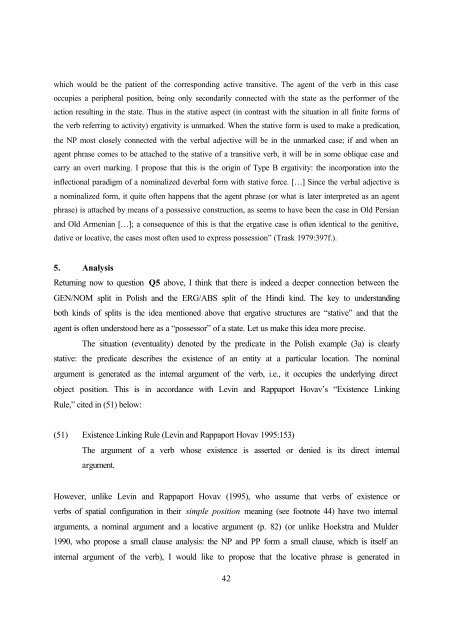Differential subject marking in Polish: The case of Genitive vs ...
Differential subject marking in Polish: The case of Genitive vs ...
Differential subject marking in Polish: The case of Genitive vs ...
Create successful ePaper yourself
Turn your PDF publications into a flip-book with our unique Google optimized e-Paper software.
which would be the patient <strong>of</strong> the correspond<strong>in</strong>g active transitive. <strong>The</strong> agent <strong>of</strong> the verb <strong>in</strong> this <strong>case</strong><br />
occupies a peripheral position, be<strong>in</strong>g only secondarily connected with the state as the performer <strong>of</strong> the<br />
action result<strong>in</strong>g <strong>in</strong> the state. Thus <strong>in</strong> the stative aspect (<strong>in</strong> contrast with the situation <strong>in</strong> all f<strong>in</strong>ite forms <strong>of</strong><br />
the verb referr<strong>in</strong>g to activity) ergativity is unmarked. When the stative form is used to make a predication,<br />
the NP most closely connected with the verbal adjective will be <strong>in</strong> the unmarked <strong>case</strong>; if and when an<br />
agent phrase comes to be attached to the stative <strong>of</strong> a transitive verb, it will be <strong>in</strong> some oblique <strong>case</strong> and<br />
carry an overt <strong>mark<strong>in</strong>g</strong>. I propose that this is the orig<strong>in</strong> <strong>of</strong> Type B ergativity: the <strong>in</strong>corporation <strong>in</strong>to the<br />
<strong>in</strong>flectional paradigm <strong>of</strong> a nom<strong>in</strong>alized deverbal form with stative force. […] S<strong>in</strong>ce the verbal adjective is<br />
a nom<strong>in</strong>alized form, it quite <strong>of</strong>ten happens that the agent phrase (or what is later <strong>in</strong>terpreted as an agent<br />
phrase) is attached by means <strong>of</strong> a possessive construction, as seems to have been the <strong>case</strong> <strong>in</strong> Old Persian<br />
and Old Armenian […]; a consequence <strong>of</strong> this is that the ergative <strong>case</strong> is <strong>of</strong>ten identical to the genitive,<br />
dative or locative, the <strong>case</strong>s most <strong>of</strong>ten used to express possession” (Trask 1979:397f.).<br />
5. Analysis<br />
Return<strong>in</strong>g now to question Q5 above, I th<strong>in</strong>k that there is <strong>in</strong>deed a deeper connection between the<br />
GEN/NOM split <strong>in</strong> <strong>Polish</strong> and the ERG/ABS split <strong>of</strong> the H<strong>in</strong>di k<strong>in</strong>d. <strong>The</strong> key to understand<strong>in</strong>g<br />
both k<strong>in</strong>ds <strong>of</strong> splits is the idea mentioned above that ergative structures are “stative” and that the<br />
agent is <strong>of</strong>ten understood here as a “possessor” <strong>of</strong> a state. Let us make this idea more precise.<br />
<strong>The</strong> situation (eventuality) denoted by the predicate <strong>in</strong> the <strong>Polish</strong> example (3a) is clearly<br />
stative: the predicate describes the existence <strong>of</strong> an entity at a particular location. <strong>The</strong> nom<strong>in</strong>al<br />
argument is generated as the <strong>in</strong>ternal argument <strong>of</strong> the verb, i.e., it occupies the underly<strong>in</strong>g direct<br />
object position. This is <strong>in</strong> accordance with Lev<strong>in</strong> and Rappaport Hovav’s “Existence L<strong>in</strong>k<strong>in</strong>g<br />
Rule,” cited <strong>in</strong> (51) below:<br />
(51) Existence L<strong>in</strong>k<strong>in</strong>g Rule (Lev<strong>in</strong> and Rappaport Hovav 1995:153)<br />
<strong>The</strong> argument <strong>of</strong> a verb whose existence is asserted or denied is its direct <strong>in</strong>ternal<br />
argument.<br />
However, unlike Lev<strong>in</strong> and Rappaport Hovav (1995), who assume that verbs <strong>of</strong> existence or<br />
verbs <strong>of</strong> spatial configuration <strong>in</strong> their simple position mean<strong>in</strong>g (see footnote 44) have two <strong>in</strong>ternal<br />
arguments, a nom<strong>in</strong>al argument and a locative argument (p. 82) (or unlike Hoekstra and Mulder<br />
1990, who propose a small clause analysis: the NP and PP form a small clause, which is itself an<br />
<strong>in</strong>ternal argument <strong>of</strong> the verb), I would like to propose that the locative phrase is generated <strong>in</strong><br />
42

















